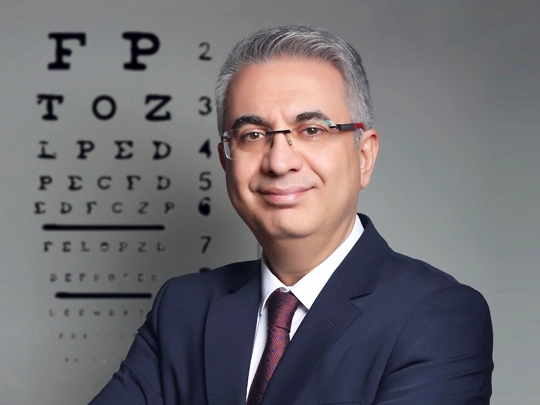
Cataract is a condition that occurs when the eye’s lens loses its transparency, becoming cloudy and impairing vision. It typically develops after the age of 60.
If one lives long enough, cataracts are inevitable. They can also appear at a younger age due to various eye diseases or genetic predispositions. There are congenital forms present at birth. For more detailed information, you can visit the cataract section on our website.
Cataract treatment at our Ankara clinic involves cataract surgery, which removes the clouded lens inside the eye. Throughout history, various methods have been employed for this procedure. Until the 1970s, intraocular lenses were not available after cataract removal, and patients had to rely on thick glasses with +14 to +15 diopters for vision correction.
The iconic "Sürahi Hanım" character on TV depicted this era. Over time, advancements led to the development of intraocular lenses and, eventually, the introduction of suture-free cataract surgery techniques, such as phacoemulsification.
Thanks to modern surgical techniques, we now achieve highly successful results with minimal risk. The most critical factors for success are an experienced surgeon, high-quality single-use surgical materials, premium lenses, and a sterile, uncrowded hospital environment. When these factors are combined, excellent outcomes can be achieved. The cost of surgery is primarily determined by the quality of materials and lenses.
Prof. Dr. Ahmet Akman has achieved excellent results in cataract surgery without compromising on quality. For detailed information on the intraocular lenses that play a crucial role in post-surgery patient satisfaction, please refer to the Intraocular Lenses section.
In cataract surgery, a 2 mm incision is made in the eye, through which a phacoemulsification device is inserted to emulsify and remove the cataract. Following this, a rolled-up lens is inserted through the 2 mm opening, where it unfolds and settles in place within the eye.
The procedure is performed under topical anesthesia using numbing drops without any injections. Depending on the patient’s preference and eye condition, either monofocal lenses for distance vision without glasses or multifocal (trifocal) lenses for glasses-free vision at near, intermediate, and distance ranges can be placed. Patients with astigmatism can also benefit from toric intraocular lenses to correct this issue.
Prof. Dr. Ahmet Akman, with experience in over 15,000 cataract surgeries and an internationally recognized scientific reputation, is a highly skilled surgeon. He is frequently invited to deliver lectures and train ophthalmologists worldwide.
Today, in cases without other eye conditions, successful surgery can achieve 100% clear vision without glasses at all distances, while significantly reducing risks. However, compromising on material quality due to financial reasons, using outdated equipment, low-quality materials from the Far East or India, or poor sterilization practices can lead to complications, including blindness or even the loss of the eye.
Prof. Dr. Ahmet Akman meticulously prepares for surgery. All lens measurements are performed using the most advanced device in the world, the Zeiss IOLMaster 700, for which Prof. Dr. Akman was the lead researcher in the first published global study. He uses only U.S.-manufactured materials and lenses during surgeries, all of which are single-use. Additionally, surgeries are performed in a hospital with top-quality air filtration systems and no COVID-19 patients.
This is one of the most frequently asked questions. The only current treatment for cataracts is surgery. Although claims about miracle plants, potions, or drugs have persisted throughout history, all of them have proven ineffective.
Today, you may encounter similar advertisements. Please do not trust them, as these claims are unscientific and unsuccessful. Cataracts result from the aging of lens cells, which stop producing transparent tissue. The aging lens becomes yellowed and eventually white, blocking light from entering the eye. No plant or drug can reverse this process.
However, measures like wearing sunglasses to protect against harmful sunlight, avoiding smoking, and maintaining a healthy diet can help delay the onset of cataracts. A diet rich in fish and seafood is particularly beneficial for eye health. Eating fish at least twice a week supports all parts of the eye.
You can call us immediately for detailed information, consultation or appointment.
Contact information